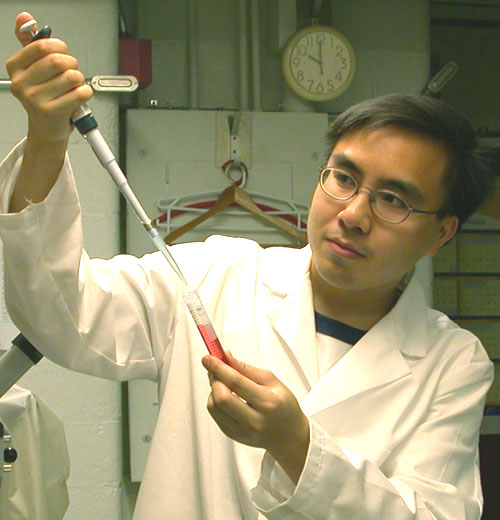Person
Wong, Kwoon
|

|
Biography and Research Interest
I have been studying the vertebrate visual system for my entire research career, using mainly electrophysiological and pharmacological techniques. For my PhD work with John Dowling at Harvard, I studied the first stage of image analysis, namely the synapse linking bipolar cells to their afferent rod and cone photoreceptors. I then became fascinated by a recently identified third photoreceptor, a type of retinal ganglion cells implicated in circadian entrainment, modulation of alertness, the pupil reflex, and other non-image-forming visual functions. I did six years of postdoctoral work with the discoverer of these ganglion-cell photoreceptors, David Berson at Brown University, studying these neurons' light responses and their signaling to the SCN, where light shifts the body’s circadian clock.
Since Jan 2010, I have been an assistant professor at the University of Michigan, in the Dept of Ophthalmology & Visual Sciences, and the Dept of Molecular, Cellular & Developmental Biology. My laboratory uses electrophysiological and imaging techniques to study the ganglion-cell photoreceptors as well as their interactions with other retinal neurons and with hypothalamic cells that regulate the circadian clock. Specifically, we seek to answer the following questions: 1) How do the ganglion-cell photoreceptors respond to light stimuli of different wavelengths, intensities and durations? 2) Which types of retinal neurons communicate with these novel photoreceptors? 3) How do the neuroactive substances released by retinal amacrine cells modulate the light response of ganglion-cell photoreceptor? 4) How does these ganglion cells’ output to the hypothalamus synchronize the circadian clock to the solar cycle? The techniques employed in these studies include patch-clamp recording, multielectrode-array recording, immunohistochemistry, calcium imaging and confocal microscopy.
The long-term goal of my research is to generate data that may guide the invention of: 1) drugs and light therapies for treating jet lag, sleep disorders and depression; 2) daytime lighting technologies that maximize alertness and hence productivity at work and in school; 3) nighttime lights that minimize the harmful effects of nocturnal light exposure while supporting image-forming visual tasks such as reading; and 4) pharmacological agents and electronic devices that enhance the visual capabilities of blind patients.
Please don't hesitate to contact me for discussion, reprints, etc.
Since Jan 2010, I have been an assistant professor at the University of Michigan, in the Dept of Ophthalmology & Visual Sciences, and the Dept of Molecular, Cellular & Developmental Biology. My laboratory uses electrophysiological and imaging techniques to study the ganglion-cell photoreceptors as well as their interactions with other retinal neurons and with hypothalamic cells that regulate the circadian clock. Specifically, we seek to answer the following questions: 1) How do the ganglion-cell photoreceptors respond to light stimuli of different wavelengths, intensities and durations? 2) Which types of retinal neurons communicate with these novel photoreceptors? 3) How do the neuroactive substances released by retinal amacrine cells modulate the light response of ganglion-cell photoreceptor? 4) How does these ganglion cells’ output to the hypothalamus synchronize the circadian clock to the solar cycle? The techniques employed in these studies include patch-clamp recording, multielectrode-array recording, immunohistochemistry, calcium imaging and confocal microscopy.
The long-term goal of my research is to generate data that may guide the invention of: 1) drugs and light therapies for treating jet lag, sleep disorders and depression; 2) daytime lighting technologies that maximize alertness and hence productivity at work and in school; 3) nighttime lights that minimize the harmful effects of nocturnal light exposure while supporting image-forming visual tasks such as reading; and 4) pharmacological agents and electronic devices that enhance the visual capabilities of blind patients.
Please don't hesitate to contact me for discussion, reprints, etc.
Non-Zebrafish Publications
Wong, K.Y. (2009) Non-Photoreceptor Photoreception. Encyclopedia of Neuroscience, 1205-1211.Wong, K.Y., Dumitrescu, O.N., Pucci, F.G., and Berson, D.M. (2008) Paradoxical ON bipolar cell input to the OFF sublamina of the inner plexiform layer provides a substrate for ON channel input to ganglion-cell photoreceptors. Society for Neuroscience, Washington D.C.
Wong, K.Y., Ecker, J.L., Dumitrescu, O.N., Berson, D.M., and Hattar, S. (2008) Multiple Morphological Types of Melanopsin Ganglion Cells with Distinct Light Responses and Axonal Targets. Association for Research in Vision and Ophthalmology, Ft. Lauderdale FL
Zhang, D.-Q., Wong, K.Y., Sollars, P.J., Berson, D.M., Pickard, G.E., and McMahon, D.G. (2008) Intraretinal signaling by ganglion cell photoreceptors to dopaminergic amacrine neurons. Proc Natl Acad Sci U S A., 105(37):14181-14186.
Graham, D.M., Wong, K.Y., Shapiro, P., Frederick, C., Pattabiraman, K., and Berson, D.M. (2008) Melanopsin Ganglion Cells Use a Membrane-associated Rhabdomeric Phototransduction Cascade. J. Neurophysiol., 99(5):2522-2532.
Wong, K.Y., Graham, D.M., and Berson, D.M. (2007) The Retina-Attached SCN Slice Preparation: An In Vitro Mammalian Circadian Visual System. J. Biol. Rhythms. 22(5):400-10.
Wong, K.Y., Dunn, D.A., Graham, D.M., and Berson, D.M. (2007) Synaptic influences on rat ganglion-cell photoreceptors. J. Physiol. 582(1):279-96.
Wong, K.Y., Dunn, F.A., and Berson, D.M. (2005) Photoreceptor adaptation in intrinsically photosensitive retinal ganglion cells. Neuron, 48(6):1001-10.
Qiu, X., Kumbalasiri, T., Carlson, S.M., Wong, K.Y., Krishna, V., Provencio, I., and Berson, D.M. (2005) Induction of photosensitivity by heterologous expression of melanopsin. Nature, 433(7027):745-749. (Related articles in The Scientist and News.Medical.net.)
Wong, K.Y., Adolph, A.R., and Dowling, J.E. (2005) Retinal Bipolar Cell Input Mechanisms in Giant Danio: I. Electroretinographic Analysis. J. Neurophysiol., 93(1):84-93.
Wong, K.Y., Cohen, E.D., and Dowling, J.E. (2005) Retinal Bipolar Cell Input Mechanisms in Giant Danio: II. Patch-Clamp Analysis of ON Bipolar Cells. J. Neurophysiol., 93(1):94-107.
Wong, K.Y. and Dowling, J.E. (2005) Retinal Bipolar Cell Input Mechanisms in Giant Danio: III. ON-OFF Bipolar Cells and Their Color-Opponent Mechanisms. J. Neurophysiol., 94(1): 265-272.
Wong, K.Y. and Rosenberg, P.A. (2005) Excitatory Amino Acid Transporters (EAATs) Modulate the Rat Electroretinogram (ERG) b-Wave Society for Neuroscience, Washington DC
